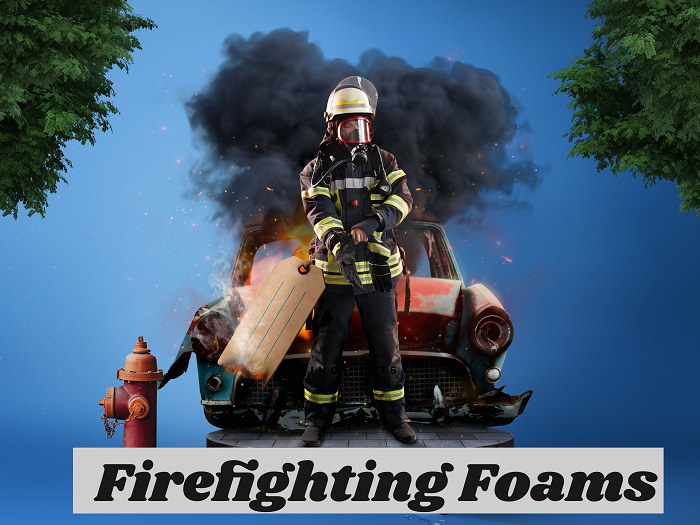A firefighter rushing towards a blazing fuel tanker. They need a foam that will knock down the fire fast before it becomes an inferno.
TorHoerman Law notes that for years, AFFF was the go-to answer. But now those same firefighters are worried. The chemicals in AFFF, those “forever chemicals,” are showing up in their blood, in their communities, and in their drinking water. The search is on for alternatives, for foams touted as safer.
But wait – are “green” foams really better?
Claims of being “eco-friendly” are flying around like sparks from that fire. Turns out, some of these new foams might be bad for the environment in different ways. Companies are rushing to sell alternatives, and let’s be honest, they want to make a profit.
So, can we find firefighting foams that actually work and keep firefighters and the planet safe? That’s the question we need to answer, and it won’t be easy.
What You Need To Know About New Foams
Fluorine-Free Foams (F3):
Think of them as AFFF’s “greener” cousin. They’re designed to knock down fuel fires fast but without PFAS chemicals. Companies are pushing the “eco-friendly” angle hard, which can be good for getting those grant dollars. Plus, no more worries about PFAS ending up in your bloodstream.
Compressed Air Foam Systems (CAFS):
CAFS whips water, foam, and air into this super-thick, clingy blanket. It’s like shaving cream on steroids. Works on both regular fires (think burning wood) and flammable liquid fires. It’s also a champ at stopping fires from re-igniting. Good for those tricky structure fires!
Cold Fire:
This is wild! It’s a water additive, so picture turning your hose into a super-powered gel blaster. This stuff cools surfaces quickly and is super sticky. Think of it as instant fire insulation – great for protecting structures.
Cold Fire isn’t always a solo act. Sometimes you might have to team it up with other foams, depending on the type of fire.
Dry Chemical Agent:
Old school, but it works! This is that powdery stuff in fire extinguishers. It’s about as fancy as baking soda, but hey, sometimes simple is best! Safe to use, easy to find, and handles specific types of fires well.
Fluoroprotein Foam With Alcohol Resistance (FPAR):
FPAR tackles a very specific problem – fires fueled by things like alcohol and ketones. It works on those tricky fires. But, it STILL got fluorinated chemicals. So, while it solves one problem, it’s not a long-term solution as safer foams get developed.
The Marketing Of “Green” Alternatives
The words “eco-friendly” and “environmentally safe” are flying around like hot embers when it comes to these new firefighting foams.
Companies know we’re all sick of PFAS and want solutions. But hold on—turns out, the Federal Trade Commission (FTC) is keeping a close eye on this. They have a history of taking action against companies across various industries for unsubstantiated “green” marketing claims. It’s shady, to say the least. Their Green Guides provide a framework for truthful environmental claims about products and services.
Make no mistake, moving away from PFAS is absolutely the right move. However, we can’t let companies fool us into thinking replacing one bad thing with a slightly less bad thing is a total win. We deserve truly safe AND effective solutions.
Industry Lobbying And Its Influence
Foam manufacturers are sweating bullets. AFFF foam lawsuits over PFAS contamination are piling up, and the government is breathing down its necks with regulations. Billion-dollar settlements are allocated for contaminated water systems, with individual health-related lawsuits still waiting for their justice.
Now throw in a whole new market for “safer” foams, and you’ve got quite a situation!
It’s no surprise companies are lobbying hard, trying to shape things in their favor. Some tactics you might see include them downplaying how well AFFF actually worked. This makes their alternatives look more appealing by comparison. They also lobby to influence how regulations are written, potentially giving their products an edge.
One major red flag is the secrecy surrounding the ingredients in some foams. Companies hide behind the excuse of “trade secrets,” but how can we trust that something is safe if we don’t know what’s in it?
Research Uncertainties And Potential Risks
Okay, let’s talk about the elephant in the room. When it comes to some of these new foams, we don’t have all the answers yet. Sure, companies claim they work on fuel fires, but how well do they stack up against AFFF in real-world situations? We need head-to-head comparisons, not just lab tests.
Unfortunately, some early research suggests certain alternatives may be toxic to aquatic life. That’s concerning, especially if lots of leftover foam ends up in runoff after a big fire. We can’t just swap one environmental issue for another.
Rushing into using a new foam without long-term studies could create a whole new mess in the future. Firefighters deserve all the facts before making decisions that affect their safety and the communities they protect.
Finding Truly Safe And Effective Solutions
The search for AFFF alternatives isn’t going to be a quick fix. Finding firefighting foams that are both safe and effective takes time, resources, and a whole lot of testing. We can’t compromise on either front. Firefighters deserve protection, as does our environment.
Thankfully, there are tools emerging to help. The GreenScreen Certified Standard is like the gold medal for foams. Products earning this designation have been rigorously vetted to confirm they are PFAS-free and don’t contain other nasty chemicals.
This cuts through the marketing and gives fire departments something reliable to hang their hats on.
When it comes down to it, we all want the same thing: safe communities, protected firefighters, and a healthy planet. Finding firefighting foams that can achieve all this without causing more harm is the challenge of our time.
The AFFF contamination crisis has been a major wake-up call. We can’t ignore the risks anymore. Let’s demand more research into truly safe alternatives, push for total transparency from foam manufacturers, and hold companies accountable.




